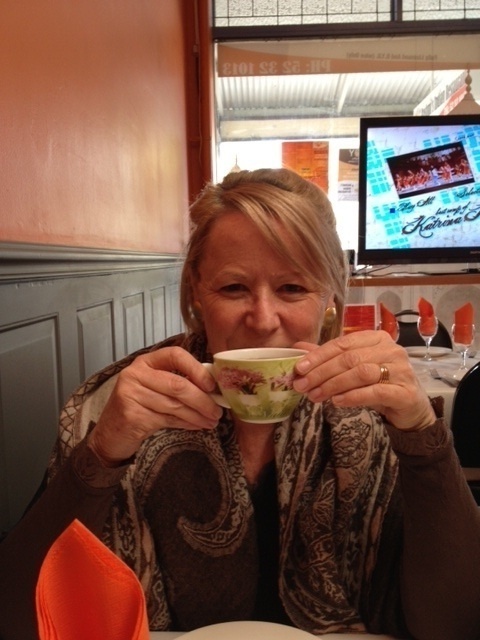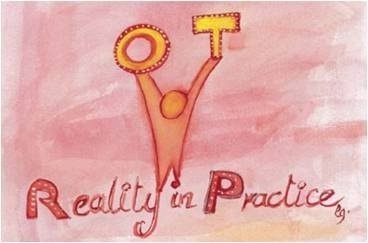
OT – The Professor made us think……
Following is a guest blog by Leonora Coolhaas, a mental health Occupational Therapist working in multi disciplinary clinical education in regional Victoria. Leonora invites you to have a look at the anzOTalk blog that supports a monthly twitter chat for Occupational Therapists and Allied Health professionals in Australia and New Zealand.
“Over the past few months it has been fantastic to be an Occupational Therapist!
We celebrated World Occupational Therapy Day in October, which culminated in a colleague winning the OT award in my organisation. Lauren Clark and I celebrated over lunch, Bollywood style, in the rural location where we work and we were completely inspired when we attended a 24 hour Virtual Conference on 30th October.
 The OT virtual exchange started in Queensland at 10 am and went for the next 24 hours across the globe. The exciting speakers included Jane Shamrock who presented about her research in East Timor. Jane won a University of Sunshine Coast prize for her presentation on researching the lives of East Timorese people who are living with a disability. She talked about the influences of historical events in East Timor and how, as an occupational therapy researcher, she needs to take a balanced view of the ways an occupational therapist from another culture approaches research. Considering the environment and such aspects as the social and political context is an important focus in occupational therapy and includes a person’s shared culture, beliefs and values as well as the buildings, public places and even the terrain and weather.
The OT virtual exchange started in Queensland at 10 am and went for the next 24 hours across the globe. The exciting speakers included Jane Shamrock who presented about her research in East Timor. Jane won a University of Sunshine Coast prize for her presentation on researching the lives of East Timorese people who are living with a disability. She talked about the influences of historical events in East Timor and how, as an occupational therapy researcher, she needs to take a balanced view of the ways an occupational therapist from another culture approaches research. Considering the environment and such aspects as the social and political context is an important focus in occupational therapy and includes a person’s shared culture, beliefs and values as well as the buildings, public places and even the terrain and weather.
Now for the Professor whose keynote address was the real highlight of the last few months for me. Professor Karen Stagnitti presented the keynote at the Victorian State Conference organised by Occupational Therapy Australia. Initially she talked about her early career and what influenced her work. She discovered a lack of information about play and this gap motivated her to do the research and work including the authorship of two play assessments, five books and over 60 national and international peer reviewed publications and book chapters: an illustrious keynote speaker indeed!
“…to exist successfully in the world requires an understanding of people”
(Dr. Carol Westby 1991)
This quote, from a Speech and Language Therapist, guided Professor Stagnitti’s address. She commenced with a caution about the assumptions we so easily make about people. She said that she teaches her students about attitudes by taking them on a field expedition to Lake Condah. At Lake Condah the students get to see the complex stone houses the Gunditjmara people developed which are the only remaining permanent houses built by an Indigenous community in Australia. Professor Stagnitti said the students generally acknowledge that their view changes when they learn about the sophisticated dwellings created and their understanding expands accordingly.
We watched a video where a ball is being passed and we were instructed to count the number of passes. This provided immediate evidence to many of us about how little we notice or pay attention. You may like to try it and see what else you notice. Professor Stagnitti then spoke about fast and slow thinking which became a unifying idea for the rest of the conference and was referred to in other presentations and conversations over lunch and coffee. This is the work of Daniel Kahneman on fast and slow thinking and the concept that really got us engaged; putting our thinking caps on as my teachers used to say so long ago.
The idea he proposes is that we operate with two systems of thinking: System 1 thinking which is fast and System 2 thinking which is slow.
“System 1 operates automatically and quickly, with little or no effort and no sense of voluntary control.”
Does System 1 thinking sound familiar? It takes care of all the simple things in our lives like reading words on a billboard, finishing the sentence “bread and…” and locating the source of a sudden sound.
System 2 thinking on the other hand requires attention and inlcudes things like parking in a narrow space, telling someone your phone number and monitoring our behaviour in a social situation.
(Kahneman p.21) Prejudices and assumptions arise when we approach a System 2 situation with System 1 thinking.
Of course this set us up really well for the rest of the conference which included some great presentations and conversations in the question times that followed. I met a number of Occupational Therapists who have worked for many years as I have and also new graduates like Amy Mahony who presented on a peer support network devleoped by and for Grade 1 OTs at Western Health.
I left VicOT12 stimulated by the current discourse in Occupational Therapy and reassured that the future of the profession is in great hands as long as we remember to put our thinking caps on.
——————————————————————————————————————————————-
Kahneman, D. (2011) “Thinking, fast and slow.” MacMillan. ISBN 978-1-4299-6935-2 Retrieved Nov 13th 2012”


